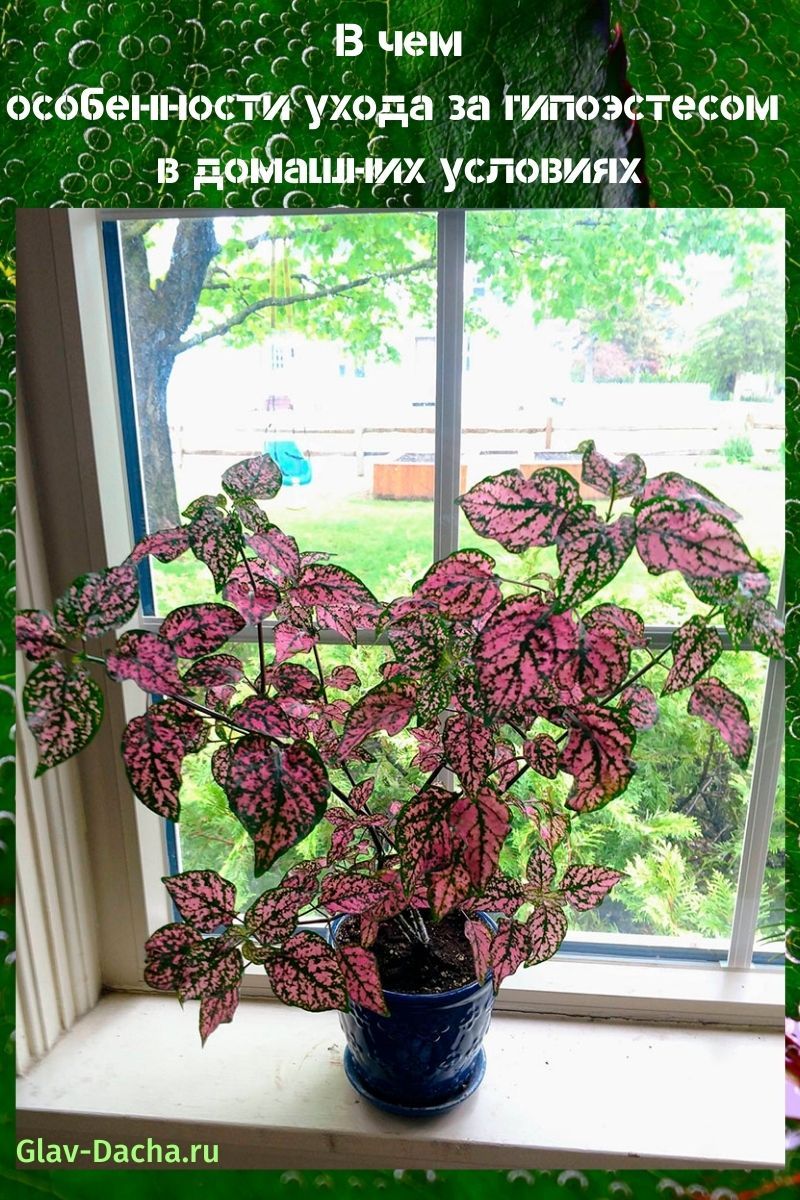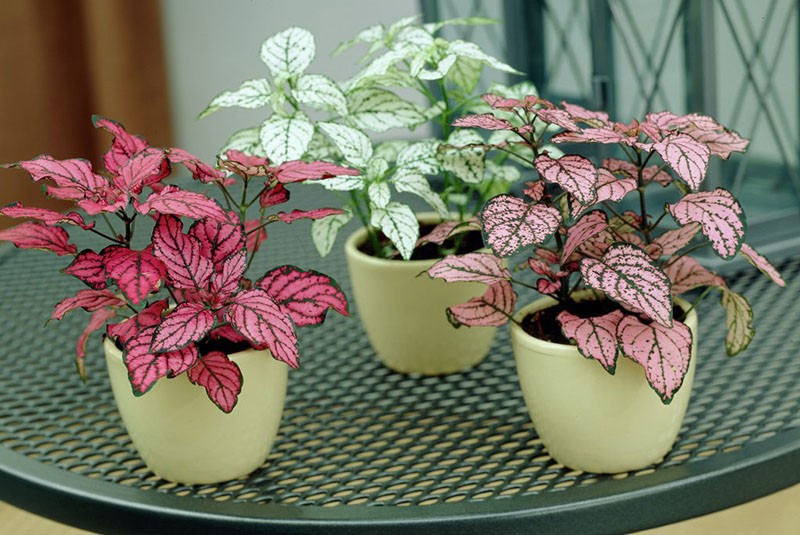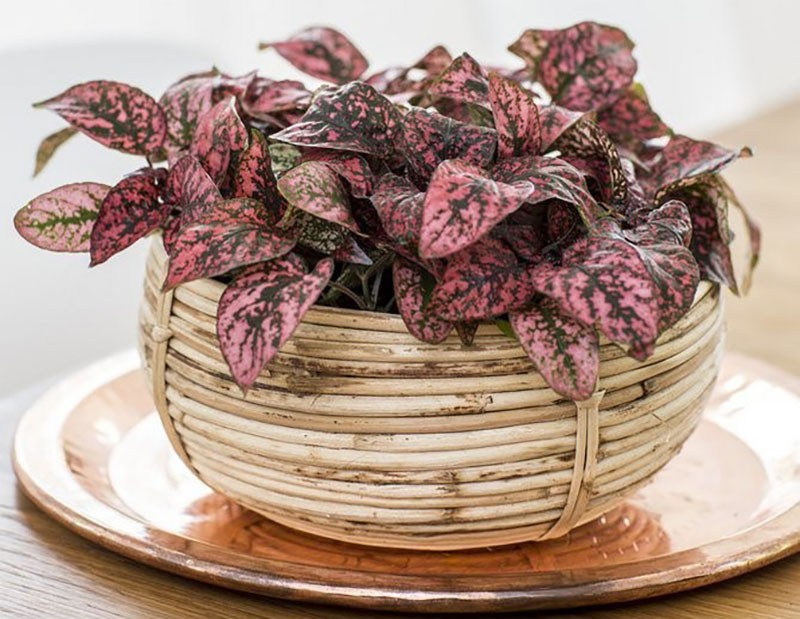What are the features of hypoesthesia care at home
 Hypoestes is a bright representative of exotic plants native to the island of Madagascar and the tropics of South America. This plant with colorful leaves is loved by many flower growers, because caring for hypoesthesia at home does not require significant physical and temporary efforts. The unpretentious tropical flower can be grown both in the garden area and as a spectacular indoor plant.
Hypoestes is a bright representative of exotic plants native to the island of Madagascar and the tropics of South America. This plant with colorful leaves is loved by many flower growers, because caring for hypoesthesia at home does not require significant physical and temporary efforts. The unpretentious tropical flower can be grown both in the garden area and as a spectacular indoor plant.
The main features of hypoesthesia


Features of hypoesthesia:
- The bush is low, reaching no more than 50-60 cm in height, compact and densely leafy.
- The plant is distinguished by strong branching, due to which during the growing season it is covered with numerous processes.
- Leaves are ovoid or heart-shaped, opposite, with pointed or even tips.
- Flowers are tubular, located in semi-umbels. The most common color of the flower is white, red or lilac.
- Depending on the type, hypoesthesia blooms in late spring or early summer and continues until the first frost.
The main distinguishing feature of hypoesthesia is the unusual, bright color of the leaves. The surface of the leaf blades is covered with small specks, resembling freckles on the face.
Depending on the variety, their color can be burgundy red, pink or silvery white.
Types of hypoesthesia
 Under natural conditions, there are at least 150 varieties of tropical plants, but only a few are grown at home.
Under natural conditions, there are at least 150 varieties of tropical plants, but only a few are grown at home.
Popular types of hypoesthesia:
- blood red;

- leaf grate.

Blood-red hypoestes is an evergreen highly branching shrub up to 40-50 cm high. It is distinguished by narrow, oval leaves 6-8 cm long. Their surface is covered with purple-reddish veins and small red spots. During the flowering period, the plant is covered with red and white flowers.
Leaf grate hypoestes - the main distinguishing feature of this species is considered to be the softish red-purple leaves, densely covering the stems of the shrub. The flowers are single, axillary, of a spectacular lavender color.
Hypoesthesia care at home - basic rules
 When caring for hypoesthesia at home, it is very important to create comfortable conditions, without which a tropical plant will quickly lose its decorative appeal. You need to choose the right pot and prepare a substrate that will provide the flower with the necessary nutrients.
When caring for hypoesthesia at home, it is very important to create comfortable conditions, without which a tropical plant will quickly lose its decorative appeal. You need to choose the right pot and prepare a substrate that will provide the flower with the necessary nutrients.
Timely watering and feeding, air temperature and humidity, prevention and control of diseases and pests are of great importance.
Lighting
 Hypoestes belongs to light-loving plants, but it does not tolerate exposure to direct sunlight. The best option would be a soft, diffused light with shading. It will provide bright saturation of hypoesthesia leaves.
Hypoestes belongs to light-loving plants, but it does not tolerate exposure to direct sunlight. The best option would be a soft, diffused light with shading. It will provide bright saturation of hypoesthesia leaves.
In winter, a tropical plant also requires an abundance of light, so it is advisable to additionally use artificial lighting lamps.
Insufficient lighting should not be allowed - from this, bright spots on its leaves turn pale and the plant loses its decorative appeal.
Pot and soil preparation
 Both clay and plastic pots can be used to grow hypoesthesia. This plant is not large in size, so the bush will not overturn the plastic container.
Both clay and plastic pots can be used to grow hypoesthesia. This plant is not large in size, so the bush will not overturn the plastic container.
It is best to choose short and wide pots. In high containers, moisture will stagnate, and this is detrimental to the delicate and superficial root system of a tropical flower. The pot must have drainage holes to drain excess moisture.
To grow hypoesthesia, you need to prepare a light, loose, nutritious and breathable soil with low or neutral acidity.
You can make it yourself from the following components:
- peat;
- humus;
- coarse river sand;
- leafy land.
These components must be mixed in a 1: 1: 1: 2 ratio. You can also use a ready-made substrate for leafy houseplants available at gardening stores.
Temperature and humidity
 When caring for hypoesthesia at home, you need to take into account that it comes from the tropics, therefore, it requires compliance with the temperature regime. In spring and summer, a thermophilic plant needs to ensure the air temperature is not lower than + 23 ° С, in winter it should not fall below + 18 ° С.
When caring for hypoesthesia at home, you need to take into account that it comes from the tropics, therefore, it requires compliance with the temperature regime. In spring and summer, a thermophilic plant needs to ensure the air temperature is not lower than + 23 ° С, in winter it should not fall below + 18 ° С.
For a rich color of hypoesthesia leaves, high humidity is very important. To do this, the foliage can be sprayed several times a day with soft, settled water from a spray bottle.
Additionally, you can put expanded clay in the pallet or sphagnum moss and pour in some water. But at the same time, you need to carefully monitor so that the bottom of the flower pot does not touch moisture.
Watering
 The amount and frequency of hypoesthesia watering depend on the season and weather conditions. In the hot summer, the plant needs abundant watering, which is carried out immediately after the top layer of the soil in the pot has dried.
The amount and frequency of hypoesthesia watering depend on the season and weather conditions. In the hot summer, the plant needs abundant watering, which is carried out immediately after the top layer of the soil in the pot has dried.
It is necessary to carefully monitor the soil and not allow it to completely dry out - this will lead to the fall of the hypoesthesia leaves. The best option is to moisturize every 2 days in summer and every 5-7 days in autumn and winter.
For watering a houseplant, you need to use only distilled or settled water, warmed to room temperature.
You can water hypoesthesia both from a watering can and by spraying an earthen coma.
Top dressing
 Hypoesthesia is fed from April to October. Fertilizers need to be applied every 20-30 days. For this purpose, it is best to use complex mineral fertilizers for flowering ornamental crops containing potassium and nitrogen.
Hypoesthesia is fed from April to October. Fertilizers need to be applied every 20-30 days. For this purpose, it is best to use complex mineral fertilizers for flowering ornamental crops containing potassium and nitrogen.
When choosing a top dressing, you need to carefully read its composition. It should be dominated by potassium, which provides lush flowering and rich color of the leaves.
Nitrogen should be kept to a minimum, since excess nitrogen can lead to dullness and loss of brightness in foliage.
Reproduction of hypoesthesia
 Reproduction of hypoesthesia is carried out by cuttings and seeds. Cuttings are considered to be more common. It can be done in spring and summer. For reproduction, shoots from the tops of a plant with two or more nodes are used.
Reproduction of hypoesthesia is carried out by cuttings and seeds. Cuttings are considered to be more common. It can be done in spring and summer. For reproduction, shoots from the tops of a plant with two or more nodes are used.
For rooting, cuttings must be planted in small plastic cups with a nutrient substrate, covered with glass and placed in a warm place with a temperature of at least + 25 ° C. After 12-15 days, young seedlings can be dived into separate pots, removing them from the glass with a spoon.
Growing hypoesthesia from seeds at home is carried out in several stages.:
- Planting work can be started in early March. You need to prepare a small plastic container and a nutrient medium from equal parts of peat and sand.
- The seeds should be soaked in a solution of Zircon, Epin or another growth stimulant for 12 hours.
- The soil in the container must be moistened abundantly.
- Spread the seeds over the surface of the substrate, lightly sprinkling with soil.
- Cover with a lid, glass or plastic and leave for 2 weeks.
- During the germination period, the seedlings must be aired daily.
- After 14 days, the seedlings can be dived and planted in separate containers.
Hypoestes is a vibrant tropical plant that can be easily grown at home. All he needs is to create a comfortable microclimate and minimal maintenance. If you follow the basic rules, you can get a colorful interior decoration with unusually bright and variegated foliage.